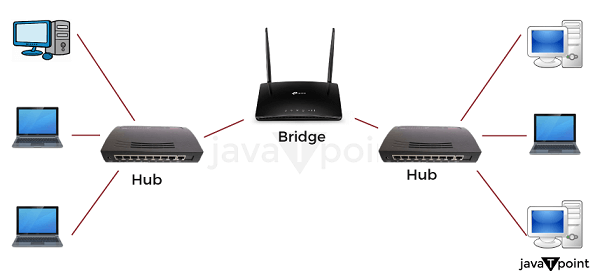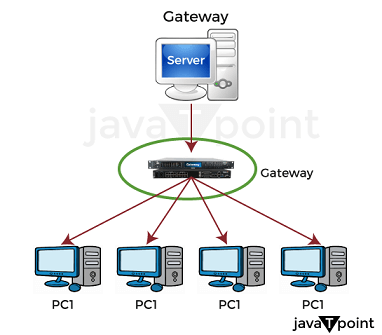Difference between Bridge and GatewayIn a computer network, physical devices are utilized to communicate with other devices. These gadgets are also referred to as Network Hardware. The basic purposes of computer networks are connectivity and network traffic control. The network may be expanded or divided by utilizing the network devices. The backbone devices of networking are the bridge and gateway. A "bridge" has two layers: the physical layer and the second one is data link layer. A "gateway" may access all seven layers of the OSI model. The key distinction between a bridge and a gateway is that a bridge is only utilized to send the frame to the intended destination in the most effictive path. Using a gateway, a packet may be converted from one protocol's format to another's format. In this article, you will learn about the difference between Bridge and Gateway. But before discussing the differences, you must know about Bridge and Gateway with their uses, advantages, and disadvantages. What is Bridge?A bridge is a type of network component that enables two distinct LAN networks to connect utilizing the same protocol. The frames are sent across two distinct LAN networks. The network hardware, such as bridges, operates in the data link layer. A bridge is a repeater that filters the information by reading the MAC address from the source. The bridge is a two-port device due to its single input and output ports. 
The bridges may be utilized to track down the computer causing the network issue by monitoring the traffic from the machines. Each network node's address is stored, and packets are sent to their destinations based on the stored address. The network is split into smaller networks by the bridge. The network is divided by the bridge utilizing different bandwidths. Additionally, keep the bridge's traffic on a different side. Working of BridgeLet's understand the working of a bridge in a computer network by utilizing the following steps:
Types of BridgesThere are mainly three types of bridges, including Source routing bridge, Transparent bridge, and Translation Bridge. 1. Source Routing Bridge It is the less expensive bridge. It only joins two LAN networks. The addresses are manually entered into the lookup table. Its maintenance takes more time than it saves money. 2. Transparent Bridge It is the most well-liked bridge with invisible devices. Since it is unknown whether the network in this bridge was added or removed, reconfiguration is not required. Bridge learning and bridge forwarding are two of the functions of this bridge. 3. Translation Bridge Translation bridge generates its look-up table dynamically and keeps it updated during its bridging activities. What is Gateway?A Gateway works on all seven layers of the OSI model. A gateway performs as a "protocol converter". A device called the Gateway connects many protocols across a fragmented network. It is a host network entry point via a distant network. In comparison to the bridge, the Gateway is more complicated and strong. 
Gateway servers are sometimes known as proxy servers or firewall servers. Gateways are responsible for the data routing. Several types of gateways are based on data flow, such as bidirectional, cloud storage gateways, unidirectional, network, and so on. The Gateway may translate between two things like electrical components and media. The gateway is more adaptable in comparison to the bridge since it translates addresses between several networks. Working of GatewayLet's understand the working of a gateway in a computer network by utilizing the following steps:
Key differences between Bridge and GatewayThere are various key differences between Bridge and Gateway. Some of the key differences between Bridge and Gateway are as follows: 
Head-to-head comparison between Bridge and GatewayHere, you will learn the head-to-head comparisons between Bridge and Gateway. The main differences between Bridge and Gateway are as follows:
ConclusionIn conclusion, bridges and gateways are the most important component of computer networking. Bridges and gateways are both the backbone of networking devices. The primary distinction between these two networking devices is that a bridge joins two networks that utilize the same protocol. In contrast, a gateway links two dissimilar networks that utilize separate protocols. Gateways may link two networks that utilize different protocols. They give network users access to systems that are not on their local networks.
Next TopicDifference Between
|
 For Videos Join Our Youtube Channel: Join Now
For Videos Join Our Youtube Channel: Join Now
Feedback
- Send your Feedback to [email protected]
Help Others, Please Share










